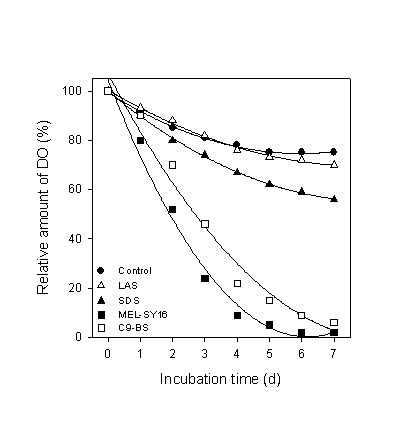|
 Characteristics
Characteristics
◈ Environmental friendly detergent with high bio-degradability
◈ Atoxic detergent not harmful to human skin
◈ Skin protection due to excellent moisturizing capability
 Uses
Uses
◈ For adding to functional cosmetics(emulsifying, dissipating,
anti-foaming capabilities)
◈ For detergent (special purpose detergent, high performance household
detergent)
◈ For bioremediation (Maximization of processing efficiency of
soil and water
system contaminated by spilled oils)
 Specification
Specification
◈ Appearance : Liquid state
◈ Constituents : Mannosylerythritol Lipid (MEL) 5%]
(less than 1% of other additives)
◈ Quality
- BioActive (liquid state) : MEL 5%(v/v)
- E. coli : Negative
- Heavy Metal (Pb) : 2 ppm or less
 Usage
Usage
◈ For Household
- In case of washing dishes, dilute proper amount of the product
in the water.
◈ Oil Tank
- In case of washing out, dilute the product with 10 - 20 times
of water to spray this with high pressure.
◈ Packing Unit
- 1L/pack
- 10 pack/box(1L X 10 ea)
◈ Storage and Warehousing Period
- Store the product in a dark place without direct sunray. Effective
for 2 years
from the date of manufacturing.
 Test Results
Test Results
Comparison of Bio-decomposability of Chemical
Surfactant and BioActive

Comparison of Cellular Toxicity of Chemical Surfactant
and BioActive
|
Surfactants
|
NR50
(g/l, w/w)
|
| LAS |
<0.01 |
| SDS |
0.05 |
| C9-BS |
0.02 |
| MEL-SY16 |
5 |
| Glycerol |
50 |
NR50 values of the test surfactants were determined
towards mouse
fibroblast L929 cells after 48 hrs exposure.
Physicochemical Properties of BioActive
|
Properties
|
BioActive
|
|
Surface activity
|
|
|
Minimum surface tension (dyne/cm)
|
29
|
|
CMC
|
10 mg/l (15 M)
|
|
HLB
|
8.6, o/w emulsifier
dispersion agent
|
|
Emulsification activity (unit)
|
70
|
|
Stability
|
|
|
pH stability
|
4 - 10
|
|
Thermal stability
|
up to 90℃ (75% in 100℃)
|
|
Salt (NaCl) resistance
|
up to 100 mM (0.6%)
|
|
Other properties
|
|
|
Toxicity (g/l, w/w)
|
5
|
|
Biodegradation
|
Good
|
- CMC value was measured with purified biosurfactant.
- Emulsification activity was measured against hydrocarbons
with crude biosurfactant at a concentration of 0.1 g/l.
- Stabilities were determined by measuring the surface
tension of biosurfactant solution.
- Salt resistance were determined by measuring emulsification
activit
|
|





